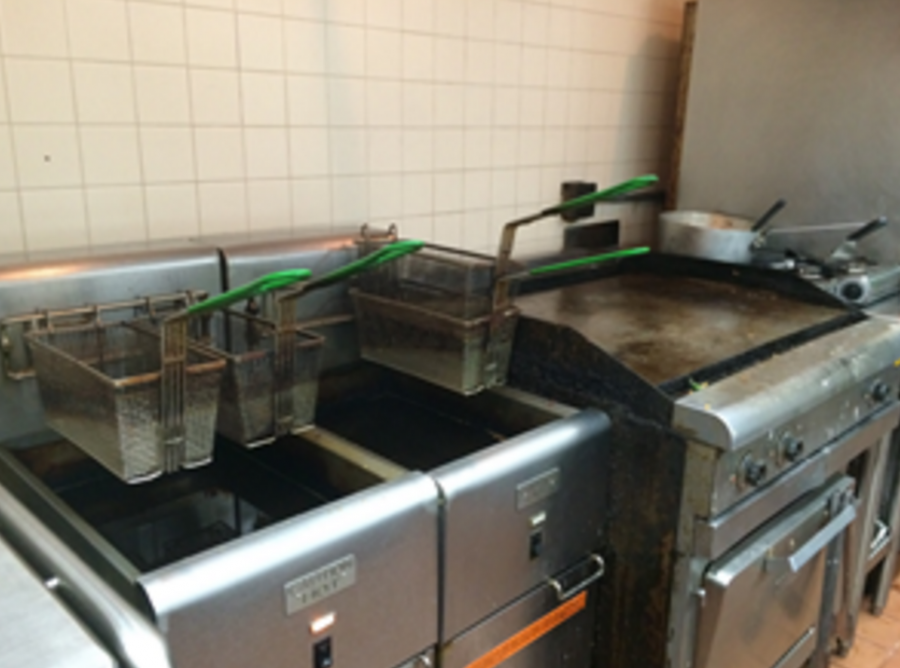Feeding 1500 Mouths Isn’t Easy
The Miami Country Day School kitchen crew have a lot on their plate preparing lunch for more than 1,500 students and faculty every day.
The cooks arrive at school at the crack of dawn to start preparations to feed our large student body. They also cook meals around the clock because of their small kitchen facilities. Many students and administrators have no idea what goes on behind the scenes.
Every day, food trucks arrive with their deliveries at the Miami Country Day campus. In the cafeteria, fifteen cooks show up at 6 a.m. to help Assistant Director Guillermo do kitchen prep for four hours before serving the first meal. “We don’t sleep,” Guillermo said, laughing.
For 25 years, SAGE dining has been catering to more than two hundred private schools across the country, including Miami Country Day School. The school’s annual food budget is about a million dollars.
Manager Manny Lacayo provided insight on where the school cafeteria food comes from and what the goals are for SAGE dining. Local farms, organic food vendors and select picking from our own school garden add to the daily mix. His cooking staff strives to make everything from scratch but also uses some processed foods. They offer fresh salads and house made dressings, a variety of whole grain breads, bagels and rolls. They roast meats and chicken breast daily. Meals are prepared with trans-fat free oils and MSG-free seasoning. Milk served is antibiotic- and hormone free milk. They use organic eggs. There are daily offer vegetarian and vegan options.
These goals are quite difficult to satisfy every day when cooking for such a large group of people. Lacayo confessed that he doesn’t meet all of them, all the time, mainly due to the size of the kitchen, prep and serving facilities.
He would prefer “having one building instead of three separate serving locations.” He would like to have action cooking and do demonstrations with posters and table tents. He tries to have his staff perform demonstrations but they are very inconsistent because of the lack of space.
During a recent interview, Guillermo talked about the hectic pace of preparing warm meals at different times of the day to feed so many students. Guillermo said the staff can’t
cook all the food at once, so they use a system called “batch to batch.” This term means serving a specific number of people at a time to keep the food fresh and warm for each scheduled meal.
“In the SAGE program, we cook batch to batch,” Guillermo said. “Some of the students come at 10:30 a.m. and some come at 12:30 p.m.”
So, what’s a typical day like behind the burners and ovens? Everyday and “everything in the kitchen is different,” he said. “The chicken breast you make on the grill. The chicken with the bun takes more time. The fish is fast and really in the moment and is faster than the chicken.”
Then he explained the “tilt skillet,” which is a huge device they use for cooking the one hundred and twenty pounds of pasta consumed by students and staff. But the Tilt Skillet only makes 20 pounds at a time, which is why Guillermo and his staff rely on the batch-to-batch cooking technique.
Despite the fact that the majority of the food and produce come from local farms, such as Wakachi, Riviera, and Homestead via distributors Trainy Brothers and Freedom Fresh, Locayo said he has heard mixed reviews over the food. The majority of the complaints are not about the taste or quality of the food but from individual families who are kosher or whose children have allergies. “There is a choice for everyone,” he said. “If you are kosher there is a salad bar, there is roast beef, and there is roast turkey, chicken breast, pasta. There is variety.”
Some fellow students of Miami Country Day offered mixed reviews.
Karl Smith, a junior at Miami Country Day, frequently eats at the cafeteria. “I think the food is inconsistent. Sometimes the chicken is flavorful but other times their meats are dry,” Karl said. “Sometimes in their burgers, I see raw meat. The choices that they offer are not quite good,” he said. “The processed foods also never look appetizing,” he added.
But that is one student’s opinion. Others like David Abrante, another junior at MCDS, were more upbeat about the food. Unlike Karl, David attended public school before coming to Miami Country Day. He has both perspectives of school lunches. “I think the cafeteria food is very good at MCDS and offers a variety of options that surpasses the quality of other schools,” David said. “Public school food is awful compared to Country Day. It wasn’t healthy at all and it didn’t taste that good either.”
SAGE’s manager said he has heard a variety of compliments and complaints. He understands that he can’t make the whole school happy, but said he does his best to appeal to everyone.
“We do try to accommodate them, but it is impossible to make everyone happy,” he said. “That’s why we give them choices. Now since we have opened our new service area. People like that we are implementing cold and hot foods. It gives them another area to eat from.”
Locayo also said that this year. SAGE has changed the dining facility and server area, adding decorations and new cooking ware. He hired four new employees to help with production.
“If we go by percentages and out of the 1,500 (and faculty) students, 60 students are not happy with the food, I’ll take those odds every time. It’s less than a percent,” he said. “Not that I want the 60 people. I hope that I don’t get any, but it’s unrealistic.”



